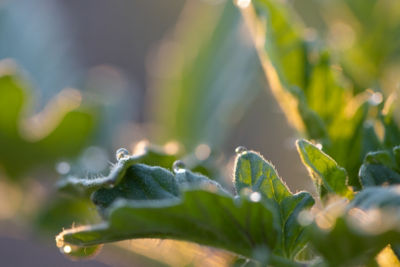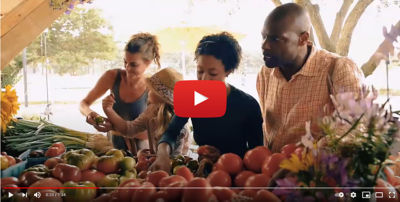Click here to download a PDF version of this spotlight.
» The development of diseases during the production of watermelon transplants can substantially impact seedling health and field production.
» The use of certified, disease-free seeds can help reduce the occurrence of many of these diseases.
» Careful sanitation and management of environmental conditions are additional tools to help disease control on transplants.
Diseases that develop on watermelon seedlings in the greenhouse can impact production in several ways. Diseases can weaken seedlings, suppressing growth and development, and some diseases kill seedlings, causing damping-off. Diseased seedlings can also serve as a source of inoculum for field plantings, initiating disease epidemics in production fields. Seedlings in the greenhouse can become infected from pathogen inoculum surviving on greenhouse surfaces, trays, equipment, and plant debris from previous crops. Some pathogens can enter the greenhouse from the outside as windblown spores, and some pathogens are seedborne. Managing diseases on seedlings in the greenhouse can improve the health of the transplants, allow for more rapid growth and establishment of field plantings, and potentially reduce the costs associated with controlling disease epidemics on a field scale.
BACTERIAL FRUIT BLOTCH
Bacterial fruit blotch (BFB) poses an economic threat to watermelon production, and infected transplants are the primary source of inoculum for plants in the field.1,2,3 The disease develops on seedlings in the greenhouse, showing up as small, water-soaked spots on the lower surface of cotyledons. The disease can spread up the hypocotyl to reach the leaves. The lesions on the leaves expand, turn necrotic and brown with water-soaked margins, and may be surrounded by a yellow halo (Figure 1). The expansion of lesions can be limited by the veins of the leaf, resulting in angular-shaped lesions.1,5 Infected seedlings may collapse and die.1,2
The development of bacterial fruit blotch is favored by warm, humid conditions and the crowded plantings seen in greenhouse production. The pathogen is spread from plant to plant by splashing water and on the hands of workers and contaminated tools. The disease can spread rapidly within the greenhouse, and one infected seed in 10,000 is enough to result in an epidemic.2,3
 Figure 1. Bacterial fuit blotch leaf lesions. Gerald Holmes, Strawberry Center, Cal Poly San Luis Obispo, Bugwood.org.
Figure 1. Bacterial fuit blotch leaf lesions. Gerald Holmes, Strawberry Center, Cal Poly San Luis Obispo, Bugwood.org.
ANGULAR LEAF SPOT
The symptoms of angular leaf spot (ALS) on watermelon seedlings are similar to those caused by bacterial fruit blotch, and laboratory testing is needed to distinguish the two diseases. The initial symptoms include small water-soaked lesions on the leaves that expand until they are delimited by the veins in the leaf, resulting in angular lesions that may have yellow margins. The presence of bacterial ooze on the lesions may make them look shiny and become a thin, white crust on the surface of the lesion. The tissue in the lesion eventually dries and tears, giving the lesion a tattered appearance. 1,2,4
The angular leaf spot bacterium is also seedborne, but the pathogen has a wide host range and can survive on some weed species. Cotyledons become infected during the germination of the seed. The pathogen is then spread to neighboring plants by splashing water, insects, workers, and tools. As with bacterial fruit blotch, wet foliage makes the spread of angular leaf spot more likely.1,2
MANAGING BFB AND ALS
Managing these bacterial diseases begins with careful sanitation in the greenhouse. Benches, walls, and walkways should be disinfected before seedlings are placed in the house. If planting trays are reused, they should be thoroughly cleaned and disinfected between crops. Only new, sterilized planting mixes should be used for germination and seedling growth. Any volunteer plants and weeds in and around the greenhouse should be removed and destroyed.1,2
Strongly consider only using seeds that have been tested and certified as disease-free. Disease assays for seed lots should use a minimum of 10,000 seeds. Seed treatments containing peroxyacetic acid, cupric acetate, hydrochloric acid, or CaOCl can help reduce any seed-to-seedling transmission of bacterial fruit blotch. If possible, avoid overhead watering and minimize the handling/touching of seedlings, especially when the foliage is wet. Watering in the middle of the day will help plants dry before nightfall. Keep the relative humidity in the greenhouse moderately low (80 to 90%) and provide good air circulation to promote rapid drying of foliage.1,2
Seedlings should be regularly inspected for symptoms, and any suspected seedlings should be sent to a diagnostic lab for verification of the presence of the pathogen. If the presence of bacterial fruit blotch is confirmed, the trays with symptomatic plants should be destroyed, and the surrounding trays should be isolated and closely monitored for symptoms. Copperbased bactericides can be applied to help minimize any spread within the greenhouse. Seedlings should be inspected before transplanting, and only symptomless seedlings should be used for transplanting.1,2
GUMMY STEM BLIGHT
The fungi that cause gummy stem blight on watermelon can survive on crop debris in the greenhouse and are also seedborne, resulting in infected transplants. Gummy stem blight symptoms first appear as circular, brown or tan spots on the cotyledons and true leaves. Some water-soaking can occur on hypocotyls, starting where the cotyledons attach and spreading downward. These lesions can girdle the hypocotyl, killing the seedling (Figure 2). 2,4
The gummy stem blight fungus can come in on infested seeds. Temperatures between 60° and 82°F and free moisture on the leaves for at least one hour are needed for infection to occur. Splashing water, workers, and contaminated tools can spread the disease to neighboring seedlings.2
Remove any debris from previous cucurbit crops from the greenhouse and disinfect surfaces, tools, and trays between plantings. Manage ventilation and watering practices to minimize the presence of free moisture on plant surfaces to reduce the chances of infection. If gummy stem blight is detected, applications of fungicides approved for use in the greenhouse can slow disease spread.
 Figure 2. A watermelon seedling girdled by gummy stem blight.
Figure 2. A watermelon seedling girdled by gummy stem blight.
ANTHRACNOSE
Anthracnose can also develop on watermelon seedlings in the greenhouse. Similar to gummy stem blight, the anthracnose pathogen can survive on seed and in crop debris in the greenhouse. Spots develop on the cotyledons and true leaves (Figure 3). The spots are water-soaked, light brown, and can have a jagged appearance. Water-soaked lesions can also develop on the hypocotyl, but this is not as common as it is with gummy stem blight. Seedlings can be killed by anthracnose infections. The disease is favored by relative humidity near 100% and temperatures between 65° and 80°F. To manage anthracnose in the greenhouse strongly consider planting only certified, disease-free seeds and apply fungicides labeled for use against anthraconse in the greenhouse.2,4
 Figure 3. Anthraconse lesions on a young watermelon leaf.
Figure 3. Anthraconse lesions on a young watermelon leaf.
FUSARIUM WILT
The Fusarium wilt fungus can survive on externally infested seeds and infect seedlings in the greenhouse. The pathogen infects through the roots and colonizes the vascular system of the plant. The tops of infected seedlings will wilt and die back, resulting in seedling damping off. Under humid conditions, white fungal growth will develop on the seedlings, and clusters of infected seedlings will develop in the trays. The main problem with this disease occurring on transplants is that they will introduce the pathogen into the field when transplanted. Once established in a field, the Fusarium wilt pathogen is nearly impossible to eradicate.2,4
No fungicides are registered for use against Fusarium wilt in the greenhouse. Management of this disease on transplants depends on planting pathogen-free seeds, using diseaseresistant varieties, and grafting onto resistant rootstocks.2,4 Trays with any symptomatic seedings should be removed and destroyed.
In general, to manage disease in watermelon transplants, focus on careful attention to the sanitation of surfaces, trays, and equipment in the greenhouse. Use only sterilized planting mix that has not come into contact with the ground. Manage environmental conditions and watering to help minimize disease development and spread. Also, strongly consider using only certified, disease-free seeds from reputable sources.2,4
SOURCES
1 Ernest, E., Everts, K., and Kleczewski, N. 2014. Watermelon seedling diseases in the greenhouse. University of Delaware, Weekly Crop Update.
2 Keinath, A., Wintermantel, W., and Zitter, T. 2017. Compendium of cucurbit diseases and pests; Second edition. The American Phytopathological Society, St. Paul.
3 Damincone, J. and Brandenberger, L. 2020. Watermelon diseases. Oklahoma State University Extension. Id: EPP-7679.
4 Egel, D. 2019. Watermelon transplant diseases. Vegetable Crops Hotline. Purdue University. Article 656.
ADDITIONAL INFORMATION
For additional agronomic information, please contact your local seed representative.
Performance may vary from location to location and from year to year, as local growing, soil and weather conditions may vary. Growers should evaluate data from multiple locations and years whenever possible and should consider the impacts of these conditions on the grower’s fields. The recommendations in this article are based upon information obtained from the cited sources and should be used as a quick reference for information about watermelon production. The content of this article should not be substituted for the professional opinion of a producer, grower, agronomist, pathologist and similar professional dealing with this specific crop.
BAYER GROUP DOES NOT WARRANT THE ACCURACY OF ANY INFORMATION OR TECHNICAL ADVICE PROVIDED HEREIN AND DISCLAIMS ALL LIABILITY FOR ANY CLAIM INVOLVING SUCH INFORMATION OR ADVICE.
7011-23401 Published 04-22-2022
Bayer, Bayer Cross Design, and Seminis® are registered trademarks of Bayer Group. All other trademarks are property of their respective owners. © 2022 Bayer Group. All rights reserved.




